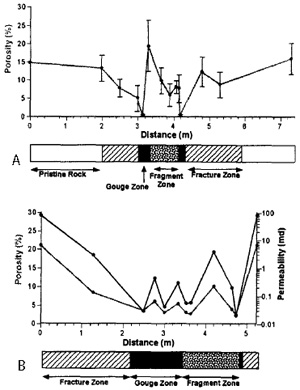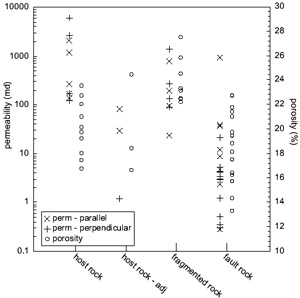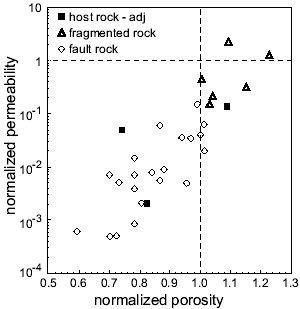| |||||||
|
|
|||||||
|
|
|||||||
| Porosity and Permeability of Sheared Joint-based Faults in Sandstone | |||||||
|
Myers et al. (1998) and Myers (1999) estimated porosity of fault rock associated with two strike-slip faults formed by sheared joints and joint zones in Aztec Sandstone at Valley of Fire State Park, NV, using the image analysis technique. In this study, the fault rock porosities are as low as 0.5%, compared to 15% of the host rock (Figure 1). Flodin et al. (2005) reported porosity measurements on the host rock, fragmented rock, and fault rock at the park with a helium porosimeter. Their results (absolute values in Figure 2 and normalized values by those for the undeformed rocks in Figure 3) show considerable overlap in fault rock, fragmented rock, and host rock values. Porosity values range between 16.6 and 24.4% for host rock, 22.5 and 27.5% for fragmented rock, and 13.3 and 22.7% for fault rock. The greatest absolute porosity reduction of fault rock with respect to median host rock is 9.1% (down from 22% for median host), which equates to a factor of 1.7 change. However, some fault rock samples show little or no change with respect to that of the median host rock. All fragmented rock samples and even two fault rock samples are dilated with respect to the median host rock porosity. A porosity increase might indicate that the sample has a higher initial porosity than the median porosity of the host rock in its original undeformed state. This is expected because there is a large variation in porosity values from one bed to another. Alternatively, the samples might have dilated relative to their original undeformed state, which is less likely.
Flodin (2003) and Flodin et al. (2005) attributed the discrepancy between their data and that of Myers et al. (1998) to optical resolution limitations inherent with the image analysis technique that they employed. Myers (1999) reported a lower optical detection limit of 20 µm. However, the median fault rock grain sizes in the samples of Flodin (2003) and Flodin et al (2005) is as small as 3 µm. In order to determine the impact of strain and burial depth on the porosity and permeability of the host rock and fault rock, Flodin (2003) and Flodin et al. (2005) investigated fault rocks subjected to different shear strain and to stepwise increasing confining pressures from 6 to 60 MPa; 60 MPa corresponding to approximately 3 km burial depth. Absolute porosity reduction between initial and final confining pressure ranges between 1.7 and 3.2%, with the majority of it occurring over the first 20 MPa of pressure increase. In addition, the authors found negligible hysteresis of porosity when the samples were returned to atmospheric confining conditions. This suggests that porosity reduction was primarily an elastic process for these samples over the range of applied confining pressures. | |||||||
| Reference: |
|||||||
| Flodin, E.A., 2003 Flodin, E.A., Gerdes, M., Aydin, A., Wiggins, W.D., 2005 Myers, R., Antonellini, M., Aydin, A., D'Onfro, P.S., 1998 Myers, R., 1999 |
|||||||
|
Readme | About Us | Acknowledgement | How to Cite | Terms of Use | Ⓒ Rock Fracture Knowledgebase |
|||||||


